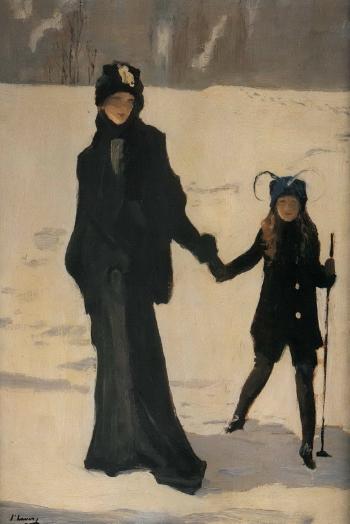The Hugh Lane, Dublin City Gallery, Parnell Square. Some of the works in their permanent collection that I particularly liked. 19th century and related works in this post.
A good example of Courbet's realism, this painting is thought to derive from an accident Courbet witnessed while on a hunting trip near his birthplace. The coach is overturned in snowdrifts so deep and sculpted that they resemble a stormy sea, the small figures dwarfed by the expansive landscape setting. The brooding sky heightens the sense of drama and the isolation of the struggling group.
Lavacourt under Snow, Claude Monet, 1878-79
A simple composition, allowing the artist to focus on the light effects on the snow.
Thoroughbred Horse, Edgar Edgas, 1865-81
Degas' interest in movement is manifest in this sculpture where the exposed spinal cord is the means of emphasizing this.
A Peasant Woman, Edgar Degas, 1871
Even though Degas is seen as an Impressionist, and drew on contemporary life for his paintings, his work differs from the work of other Impressionists in that it displays no dissolution of form. His preoccupation in this small painting was to tackle the problems of painting white material against light, with its opposing qualities of transparency and opacity. The girl's white headdress is illuminated by the bright sunlight that pours in through a transparent white curtain. This painting also reveals his preoccupation with contre-jour, modelling mass against light.
The Age of Bronze, August Rodin, 1976-77
When the Franco-Prussian war broke out, commissions became scarce and Rodin went to Brussels for several years. There, he first received public recognition with this life-size nude, which he exhibited in 1977. There is no attempt to idealise this figure and this uncompromising naturalism led to controversy and allegations that it was cast from life when the work was exhibited at the Paris Salon under the new title, The Age of Bronze. It is a representation of one of the four ages of man as described by Hesiod. Michelangelo's influence is in evidence here, recalling Dying Slave.
Jour d'Ete, Berthe Morisot, 1879
Even though this is part of the Hugh Lane's permanent collection, we did not see it as it was not being exhibited at the time we visited. I wanted to include it however, and so I have.
An informal composition, featuring two fashionably dressed young women, in a boat floating on a lake. One of the women is seen in profile and appears to be observing three ducks nearby, while the other woman looks directly out at the viewer. On the far shore, there is a tiny detail of a horse-drawn carriage moving swiftly along.
Morisot's technique, based on touches of paint applied in every direction, gives her works a transparent, iridescent quality evident in the shimmering water. The painting is quintessentially impressionist in its attempt to capture the play of light in the scene.
Waterloo Bridge, Claude Monet, 1900
Like all the Impressionists, Monet worked 'en plein air'. He carried half a dozen or more canvases to a chosen spot and set up a different canvas every half hour, returning to complete the picture when the light was the same, in resolute fidelity to the impression, to the quality of light and atmosphere and to the subtle changes that appeared in the course of the day. The early morning traffic in this painting is indicated by light touches of vibrant reds and pinks. The vertical smoking chimneys in the distance counterbalance the horizontality of the bridge. His intention was to capture the essence of London, with its extraordinary light effects and atmosphere created by the combination of mist and smoke, both industrial and domestic.
Boulevard de Clichy, Pierre Bonnard, 1911
The Boulevard de Clichy on a rainy day with the dome of the Sacre Coeur visible in the background.
A painting that is close to Impressionism, not just because of the depiction of modern life, but also in the handling of the brustroke. Influences from Japanese woodblock prints, photography and the work of Degas are also evident.
Sur La Plage, Edgar Degas, 1917
The flattened figures in this painting owe a debt to Japanese woodcuts, as does the chopped frame, particularly around the bag and umbrella. The combining influences of Oriental composition and Western imagery result in a revolutionary realism.
Japanese Switzerland, John Lavery, 1913.
Source: Dublin City Gallery, The Hugh Lane catalogue.











No comments:
Post a Comment